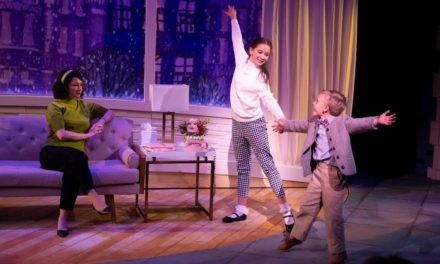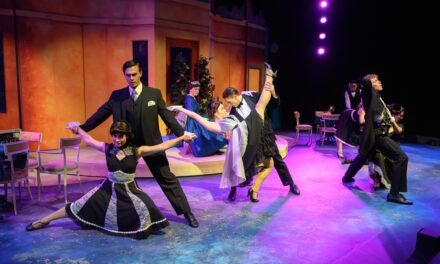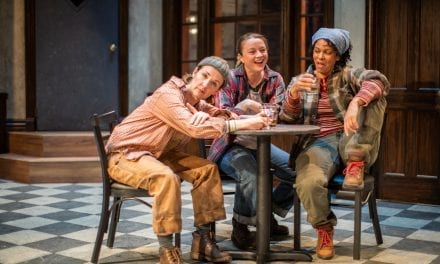WEST VALLEY CITY — If you haven’t seen the iconic movie musical The Sound of Music, you might as well be hiding your head in some proverbial sand. To say the movie is a classic is a gross understatement—it is Julie Andrews at some of her best, and musical theater transformed to the movie screen in a way that is memorable, touching, and effective. I personally was raised on this movie and attribute a lot of my love for musical theater to it.
To produce the stage version of the musical in a way that is both comfortingly familiar to those who know the musical well—such as myself—while at the same time creating something that is fresh and unique, is no small feat. But the director, Christopher Clark, and the music director, Anne Puzey, pulled it off and put on an entertaining, enjoyable musical filled with an all-around talented cast.
That said, I was a little underwhelmed by the choice to almost precisely mimic the movie at parts, particularly in “Sixteen Going on Seventeen.” As a pre-teen and teenager, I loved this scene in the movie so much that it became ritual for me to watch and re-watch it at least weekly as I worked out on our home treadmill. Therefore, every glance, every skirt flip, and every dance move is permanently ingrained in my brain. Hale Centre Theatre’s “Sixteen Going on Seventeen” seemed copied straight from the movie and I longed for some more variety. The singing was well executed, but the choreography, the skirt flicks over the benches, and even the facial expressions could have used some originality. As it was, this copycat scene bored me a bit and felt overly artificial. It didn’t bother my husband—but he hasn’t watched the movie scene the thousands of times I have.
All of the von Trapp kid actors were impressive—and they had some pretty difficult numbers, such as an a cappella reprise of “The Sound of Music” in the second act. The kids had amazing vigor and enthusiasm on-stage and they all worked together well to form a believable “family.”
The show’s golden moments were always when Maria and the children were on stage together. I particularly loved “Do Re Mi”with its fun choreography, energy, and amazing chemistry between the children and Maria. Happily, choreographer Marilyn May Montgomery took this number in some new and exciting directions. It had a lot of personality and was extremely entertaining to watch as the choreography changed and shifted as the song progressed and evolved.
Living up to an iconic character like Julie Andrews’ Maria is a challenge. I was nervous at first that Cecily Ellis-Bills wouldn’t hold up to my preconceived notions of the character and what she could be. But as the show went on, I adored her version of Maria. First, Ellis-Bills’ voice is impeccable—honestly always on, with a gorgeous, rich tone, clear diction, amazing fluidity and flow. She obviously has a lot of raw talent which she has worked hard to train to the highest level of vocal technique. I’ll admit, she seemed to lay the sappy sweetness on a little too thick at first—but like in many musicals, as I got “swept up” in the show’s world, her vivacious heartiness fit.
The number one scene stealer in this production was little Lily Carlson who played the part of Gretl, the youngest von Trapp child. She was simply adorable and added so much fun energy to an already entertaining show. You could tell she was just playing the whole time and having a blast. And she was heart-breakingly cute.
Mark Knowles, who played Captain Georg von Trapp, took a little while to win me over. He was so stoic and monotone in the first act that I couldn’t tell if he was making a conscious character choice or if he was just falling short in his acting. However, in the second act, Knowles showed through his portrayal of the character’s emotional transformation that he was indeed making a conscious choice in the first act to act aloof and unemotional. He masterfully brought warmth and life to Captain von Trapp in the second act as the character’s heart was touched by Maria and his children. The acting was so believable, in fact, that I even felt intrusive watching the incredibly intimate musical number “Something Good” between the Captain and Maria. I’m pretty sure I was bright red from blushing by the end of the song.
One happy improvement on the movie was the pacing onstage, particularly in the often fast-forwarded (at least in my home) “Climb Every Mountain.” (It’s a beautiful song—but in the movie it just goes on and on and on.) Martha West Glissmeyer as Mother Abbess gave the song the beauty and depth it needed, along with a nice versatility that is somewhat lacking in the movie. She put real emotion into the song with lovely phrasing and dynamics, all in her deeply resonant, almost overwhelmingly powerful voice. I was surprised, given my history with the song, that I enjoyed every minute and wasn’t even antsy for it to end.
All in all, this production of The Sound of Music is not completely original—but that was not to be expected or even desired—and there was enough variety and creativity in the performance to leave me satisfied and even in awe at times. Though the Julie Andrews movie musical will always be top-notch to me, it was refreshing to feel the vibrant energy that you can get only with live theater. If you, like me, grew up watching The Sound of Music as musical theatre bread-and-butter, you will enjoy this show. And if you haven’t loved The Sound of Music before, I suggest you give it another try, this time live. It may just become one of your favorite things.





